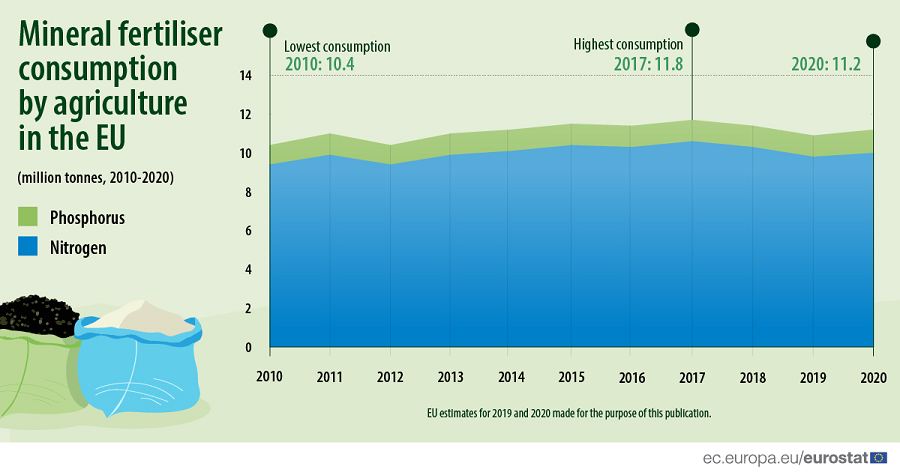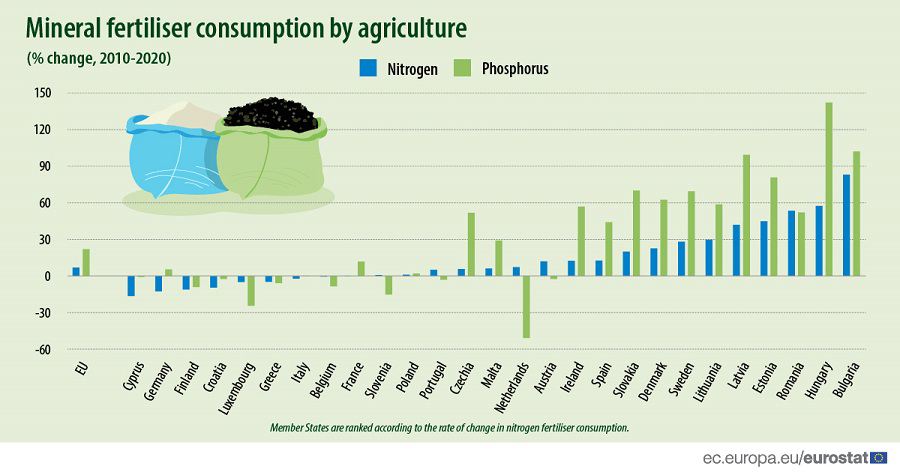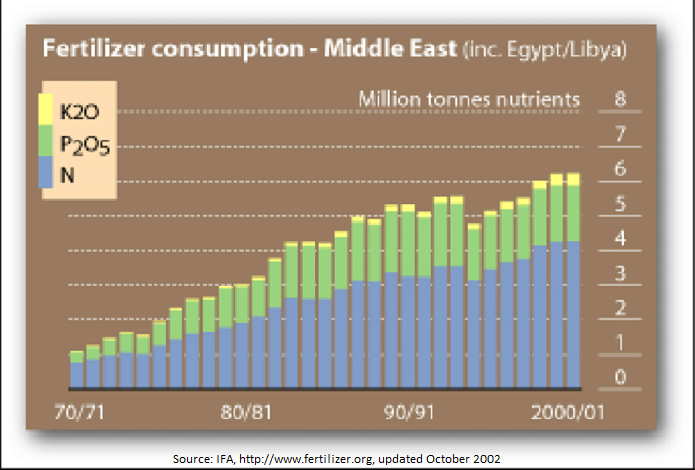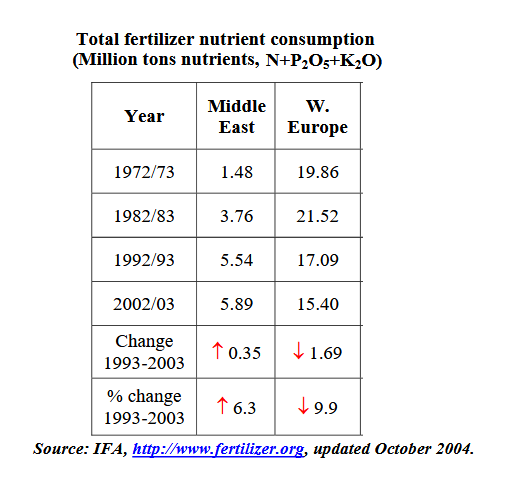In this article we discuss about fertilizers. First of all, we have tried to define fertilizers in simple words. After that, comprise fertilizer consumption in European countries against middle East countries. Also we have talked around Consequences of excessive consumption fertilizers through several aspects…
By Hossein Nazarian, Cademix Institute of Technology
What Is The Fertilizer In Simple Word
fertilizer, is a natural or synthetic substance with chemical components that enhance plant growth and productivity. Fertilizers may restore chemical elements that previous crops removed from the soil or increase the land’s inherent fertility.
When other conditions (such as light, moisture, temperature, and soil structure) are favorable, soil fertility is the property of a soil that permits it to provide chemicals in appropriate numbers and proper balance to encourage plant growth.
To provide the necessary plant nutrients in poor soils, natural or artificial materials may be supplied.
Fertilizers Essentiality, And Potential Side Effects
Fertilizers have been crucial in providing food for a growing world population.
It is predictable, a little less than half of the world’s population to be dependent on synthetic fertilizers.
Modern irrigated agriculture is increasingly using fertilization. Because it increases fertilization effectiveness and gives farmers more control over when to apply fertilizer in response to crop needs. Proper fertilization programs, increase the effectiveness of water utilization as well as crop yield.
Additionally, they can assist the environment because fertilizers can boost crop production.
Increasing crop yields might allow us to use less land for agriculture. However, they also harm the ecosystem. Many nations overuse fertilizers, which causes nutrient runoff into ecosystems and water systems. Utilizing fertilizers effectively is a challenge we must address in order to feed a growing population. Due to minimizing the harm they do to the environment.
Mineral fertilizer consumption In Europe
In the EU, 11.2 million tonnes of nitrogen and phosphorus-containing mineral fertilizers used in agricultural output in 2020. This was a 2.9% year-over-year rise from 2019 and an 8.3% increase from 2010.
Estimates state that the quantity of nitrogen fertilizer consumption by agriculture in the EU in 2020 will be 10 million tonnes. And it is is close to the average usage between 2010 and 2019.
At 1.2 million tonnes, the consumption of phosphorus fertilizers in 2020 was greater than the medium-term average.

Agricultural Use Of mineral Fertilizer
Fertilizer Consumption Records In Europe
In 2020, the agricultural sectors in France, Germany, Poland, and Spain consumed between 1.0 and 2.1 million tonnes of nitrogen fertiliser and between 0.1 and 0.2 million tonnes of phosphorous fertiliser. These countries are the largest agricultural producers and have the largest utilised agricultural areas.
The majority of Member States saw an increase in the usage of nitrogen fertilizers in agriculture between 2010 and 2020, with Bulgaria (+83.0%), Hungary (+57.5%), and Romania (+53.4%) recording the fastest growth.
Similar to this, most Member States reported an increase in the usage of phosphorus fertilizers, with Hungary (+142.2%), Bulgaria (+102.1%), and Latvia (+99.4%) reporting the largest increases.
These specific gains can be an indicator of these countries’ convergence.

Nitrogenous fertilizers production implementing by natural gas as an energy input. Price of N fertilizers directly associated with oil prices (ammonia, urea, and ammonium nitrate). There are substantial production and shipping expenses which also influenced by the price of oil, because phosphorus mines placed outside of the EU.
Production of nitrogen-based fertilizers in the EU relates on gas with Russian origin, and that Belarus and Russia are major producers of rock-based fertilizers globally (phosphates and particularly potassium).
It is predictable that the use of fertilizers in EU agriculture would change as a result of the high rise in fertilizer costs in 2022 caused by the conflict in Ukraine and the application of sanctions against Russia. (European Commission, 2022).
Fertilizer Status in Middle East
The Middle East is now the largest food importing region in the developing world and a significant producer of fertilizers globally.
Proper plant nutrition management is crucial due to the paucity of arable land and the severe water shortage.
The Middle East is the world’s largest importer of food and a major producer of fertilizers. In the M.E., the usage of N fertilizers has steadily increased during the last three decades.
Although at a slower rate than N fertilizers, the use of P fertilizers also grew. However, the use of K fertilizers did not rise at the same rate as that of N or P.

Fertilizer Consumption in Middle East
Around 7.9 million tons of fertilizer were produced overall in 18 Arab countries in 1997, of which 2.8 million tons were used domestically and roughly 5 million tons were exported to other nations.
The amount of fertilizer used per unit area varies greatly throughout the region, from 50 kg/ha in Sudan to 347 kg/ha in Egypt, and more than 7000 kg/ha is used to produce protected vegetables in the United Arab Emirates and other Middle Eastern nations.
In the Middle East, nitrogen is by far the most often eaten nutrient. Over the past two decades, a consistent rise in the use of N-fertilizers in the Near East region has been seen. P-fertilizer use also increased, though more slowly than N-fertilizer use. Unlike the consumption of N or P fertilizers, K fertilizer consumption did not rise.
The Middle East consumes fertilizer at a ratio of 10N: 5P2 O 5: 0.2K 2 O, with nitrogen accounting for 65% of use, P2 O 5 for 32%, and K 2 O for 7%.
Fertilizer Consumption Trends In Middle East And Europe
Statistics of the International Chemical Fertilizers Association (IFA) shows that the total nutrient consumption of the Middle East countries in 1993 was 5.54 and in 2003 it was 5.89 million tons. There is an increase of 6.3% during 10 years (0.63% per Year). Generally, Chemical fertilizers consumption are declining in Europe and developed countries. Because its effect Environmental and green movements that are continuously increasing Political support.

Here it is some of my articles you can find them:
- Vertical Farming With Artificial Light
- Growing in Sawdust: Alternative Planting Medium in Vertical farming.
- Healthy Food Production Challenges in Developing Countries.
- In vitro Regeneration of Alstroemeria cv. ‘Balance’ by Indirect Organogenesis.
- In vitro Regeneration of Alstroemeria cv. ‘Balance’ Based on Direct Organogenesis.
- Innovative Optimal Approach to Implement Fast Propagation Tissue Culture.
Feel free to contact me for questions, consulting or any projects.
Email: hossein_nazarian@yahoo.com
Email: hossein.nazarian@cademix.org
LinkedIn: https://www.linkedin.com/in/hossein-nazarian/
Xing: https://www.xing.com/profile/Hossein_Nazarian
About the Author
Hossein Nazarian is a graduate of MSc. in Agricultural Biotechnology Engineering from Iran and an associate member at the Cademix Institute of Technology and the Cademix Career Autopilot Program.
He has also obtained his bachelor diploma in Plant Production Engineering which has provided him with an understanding of different aspects of agriculture. For instance he was working on cultivation, irrigation, fertilization, plant protection and commercial services. He has been working in several areas in agricultural sector since 2009. He has valuable experiences as an instructor and technical expert in plant pests, diseases, nutrition, and plant protection programs. Also He he has some experiences in the greenhouse cultures and plantlets produce through artificial light in the shelves. He has been working in agribusinesses for 12 years and try to solve farmers’ problems. Further he helps to produce healthy products to improve the health level of society.
Specialties: Plant nutrition, Plant protection, Field management. Greenhouse consultant (rose, cucumber, strawberry, transplant,…), Tissue culture, Marketing, Agile management.
Keywords related to Fertilizers
Fertilizer, Fertility, Chemical elements, Plant productiveness, Natural fertility, Soil amendment, Nitrogen, Phosphorus, Potassium, Commercial fertilizers, manure, Compost, Dung, Guano. In addition, Humus, Maul, Mulch, Potash, Nitrogen fertilizers, Nitrogen fertilizers with inhibitors. Phosphorus fertilizers, Potassium fertilizers, Fertilizer consumption, Fertilizer use, Fertilizer utility. Further, Fertilizer efficiency, Global fertilizer, Plant nutrition, Controlled-release fertilizer, Slow release fertilizer, Agriculture, Agronomy, Sustainable agriculture, European countries, Middle east countries.
